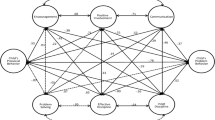Abstract
The effects of various degrees of structure during clinic observations and the location of the observation (home or clinic) on the behaviors of mothers and children were examined. Forty families with conduct-problem children between the ages of 3 and 8 years participated. Correlations indicated little relationship between behavior in structured and in unstructured clinic conditions. There was also a lack of correlation between the structured clinic and the home observations. However, there were high correlations between mothers' and children's behaviors in the unstructured clinic observation and the home observations. ANOVA further indicated that there were significant differences between the actual rates of behaviors observed in the home and clinic locations. Results are discussed in relation to the potential of structured clinic observations to provide more relevant and efficient information about mothers and conduct-problem children.
Similar content being viewed by others
References
Belsky, S. (1980). Mother-infant interaction in the home and in the laboratory: A comparative study.Journal of Genetic Psychology, 137, 37–47.
Bornstein, P. H., Bridgewater, C. A., Hickey, J. C., & Sweeney, T. M. (1980). Characteristics and trends in behavioral assessment: An archival analysis.Behavioral Assessment, 2, 125–133.
Eyberg, S. M. (1980). Eyberg Child Behavior Inventory.Journal of Clinical Child Psychology, 9(1), 29.
Eyberg, S. M., & Ross, A. W. (1978). Assessment of child behavior problems: The validation of a new inventory.Journal of Clinical Child Psychology, 16, 113–116.
Forehand, R., King, H. E., Reid, S., & Yoder, P. (1975). Mother-child interactions: Comparison of a noncompliant clinic group and a nonclinic group.Behaviour Research and Therapy, 13, 79–84.
Hollingshead, A. B., & Redlich, F. C. (1957).Social class and mental illness (pp. 398–407). New York: Wiley.
Hughes, H. M., & Haynes, S. N. (1978). Structured laboratory observation in the behavioral assessment of parent-child interactions: A methodological critique.Behavior Therapy, 7, 428–447.
Johnson, S. M., & Bolstad, O. D. (1973). Methodological issues in naturalistic observations: Some problems and solutions for field research. In L. A. Hamerlynck, L. C. Handy, & E. J. Mash (Eds.),Behavior change: Methodology, concepts and practice. Champaign, Illinois: Research Press.
Kniskern, J. R., Robinson, E. A., & Mitchell, S. K. (1983). Mother-child interaction in the home and laboratory settings.Child Study Journal, 13, 23–29.
Kogan, K. E., &, Wimberger, H. C. (1971). Behavior transactions between disturbed children and their mothers.Psychological Reports, 28, 395–404.
Mash, E. J., & Terdal, L. G. (1982). Behavioral assessment of childhood disturbance. In E. J. Mash & L. G. Terdal (Eds.),Behavioral assessment of childhood disorders. New York: Guilford Press.
Robinson, E. A., & Eyberg, S. M. (1981). The dyadic parent-child interaction coding system: Standardization and validation.Journal of Consulting and Clinical Psychology, 49, 245–250.
Sajwaj, T. (1973). Difficulties in the use of behavioral techniques by parents in changing child's behavior: Guide to success.Journal of Nervous and Mental Disease, 56, 395–403.
Webster-Stratton, C. (1984). Comparison of two parent training programs for conduct problem children.Journal of Consulting and Clinical Psychology, 52, 666–678.
Zangwill, W. M., & Kniskern, J. R. (1982). Comparison of problem families in the clinic and at home.Behavior Therapy, 13, 145–152.
Author information
Authors and Affiliations
Additional information
This research was supported in part by a University of Washington School of Nursing Biomedical Research Services Grant and by Graduate School Research funds. Appreciation is expressed to Barbara Hummel for her skillful assistance in the preparation of the manuscript. The author is also grateful to a number of people who assisted in extensive work related to data collection and data management: Jeanne Bourget, Janet Cady, Melanie Calderwood, Jayne Eriks, Maxime Fookson, Don Goldstein, Terri Hollinsworth, Margaret Jarvis, Liz LeCuyer, Sharon McNamara, Judi Withers, and Bernice Yates. Finally, thanks also go to Bob Abbott for his statistical consultation and to Sandy Mitchell for manuscript review.
Rights and permissions
About this article
Cite this article
Webster-Stratton, C. Comparisons of behavior transactions between conduct-disordered children and their mothers in the clinic and at home. J Abnorm Child Psychol 13, 169–183 (1985). https://doi.org/10.1007/BF00910640
Revised:
Issue Date:
DOI: https://doi.org/10.1007/BF00910640




